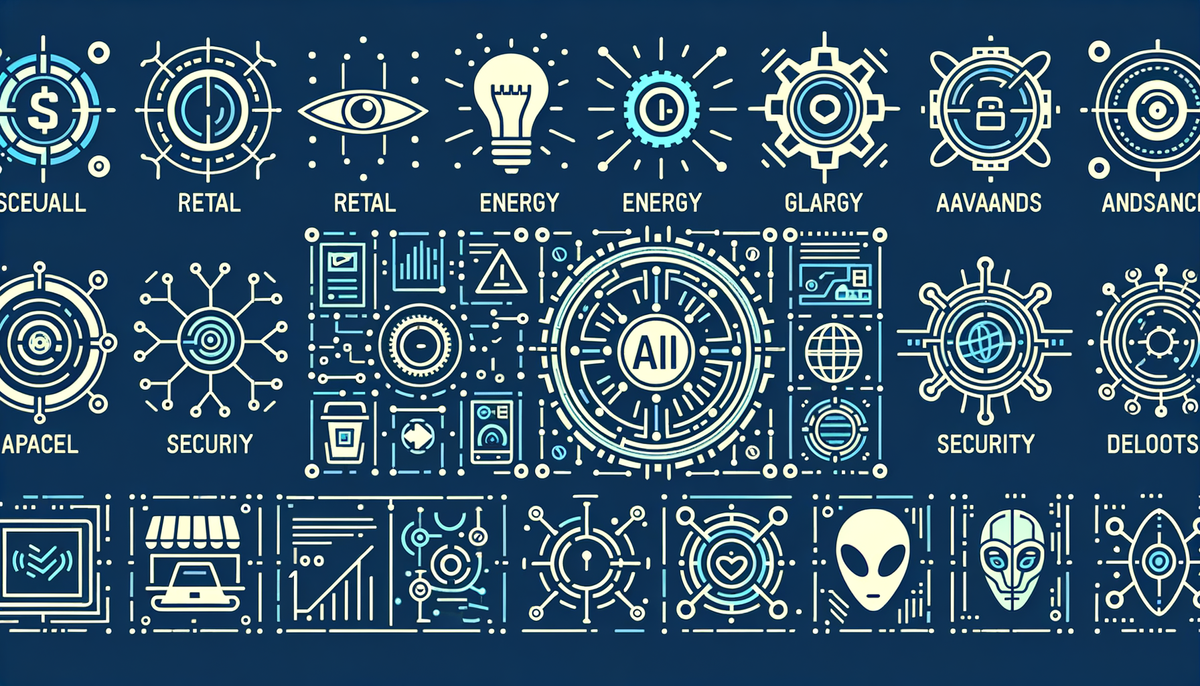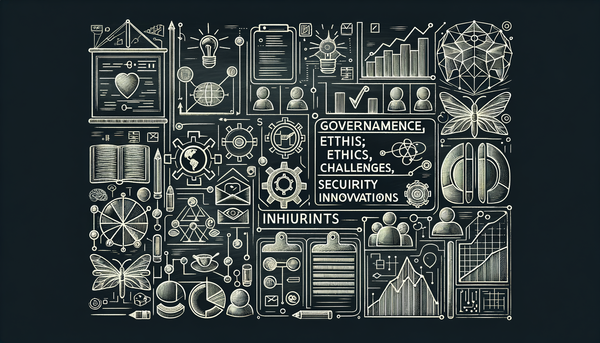AI News Podcast Update: Diverse Advances in AI

Amid groundbreaking innovations that are reshaping retail experiences, energy ventures, security protocols, and even gameplay performance, recent AI advancements are painting a future where technology touches every aspect of our lives. From AI-powered store summaries in browsers to transformative hardware improvements and controversial policy maneuvers, today's update weaves together a vibrant tapestry of progress and challenges in the AI landscape.
Retail Innovations: AI-Driven Shopping Experiences
Imagine browsing your favorite online store and receiving a succinct, intelligent summary of available products—all thanks to AI. Google Chrome's recent addition of AI-powered store summaries aims to elevate the shopping experience in the United States, seamlessly condensing product details into clear, digestible highlights. This innovation not only saves time but also enhances decision-making, underscoring the potential for AI tools to transform everyday activities.
Such developments reflect a broader trend in retail technology, where machine learning is employed to curate and personalize content for shoppers. This approach, seen in other tech innovations on AI.Biz, is emblematic of the ways artificial intelligence is redefining user engagement. By intelligently aggregating content, AI enables a fluid transition from traditional e-commerce browsing to a digitally enhanced, efficient shopping experience.
As more companies adopt similar strategies, we can expect less clutter and more relevant, tailored information delivered in real time. This evolution promises significant benefits for both consumers and businesses and may serve as a catalyst for even more personalized digital interactions in the near future.
Energy and Business Impacts: The AI Advantage in Finance
The business world is reaping the rewards of AI integration, as demonstrated by Bloom Energy's impressive 37% stock jump following a new deal with an AI firm. This partnership highlights how AI can expedite operational efficiency, optimize energy production, and drive financial performance by analyzing massive datasets to predict energy demand and supply patterns with increased accuracy.
Bloom Energy's surge underscores a vital transition for industries traditionally reliant on conventional energy practices. By incorporating AI into their strategies, companies like Bloom are not only embracing technological innovation—they're also establishing a competitive edge well recognized by investors. As detailed in our industry insights on AI.Biz, such strategic moves often prelude broader trends that could reshape market dynamics across sectors.
Integrating AI into business models is proving to be a lever for substantial change. The deployment of predictive analytics and real-time data processing not only sharpens decision-making in energy production but also enhances risk management and maintenance operations. As noted by experts, such efficiencies could eventually lead to reduced operational costs and a more sustainable energy sector, fostering a virtuous cycle of innovation and growth.
Securing Infrastructure: AI Solutions in Transportation and Cloud Safety
Safety and efficiency in critical infrastructure have never been more crucial. BigBear.ai's deployment of AI solutions at major airports like LAX and DFW is a prime example of how artificial intelligence is being harnessed to optimize traffic flow, enhance security measures, and predict maintenance needs in bustling environments. Such advancements are redefining the standards in transportation and security management.
Concurrent with these practical applications in physical infrastructure, AI is also proving vital in digital realms. The introduction of TotalAI by Qualys for securing cloud AI and large language models (LLMs) marks a significant leap in risk management. By providing comprehensive visibility, risk context, and control, TotalAI helps enterprises combat evolving cybersecurity threats, ensuring robust defense mechanisms are in place to guard their digital assets.
This dual approach—enhancing physical infrastructure security through BigBear.ai and fortifying digital defenses via TotalAI—illustrates the multi-faceted impact of AI. It bridges the gap between convenience and security, merging real-world applications with advanced data protection techniques. As governments and enterprises increasingly rely on these technologies, collaboration between tech developers and regulatory bodies becomes essential for balancing innovation with safety.
Trust and Governance: Verifiable Models and Regulatory Crossroads
In an age where artificial intelligence plays an ever-growing role in decision-making, ensuring the trustworthiness of AI models has become critical. NVIDIA's introduction of Model Signing in NGC is a step toward verifiable trust in AI. This development ensures that the models being deployed are secure, authentic, and verifiable—a must-have in scenarios where tampering or unauthorized modifications can lead to significant consequences.
This initiative to create robust security frameworks for AI models pairs interestingly with recent regulatory shifts in political spheres. The contentious AI Action Plan under the Trump Administration has sparked debates over ideological biases and federal oversight in AI technology. Critics argue that initiatives to prune state regulations could undermine essential ethical safeguards, creating regulatory uncertainty across the board.
One cannot ignore the tension between fostering AI innovation and instituting effective governance. The plan's ambiguous definitions of "AI-related" funding have placed state officials in a challenging position. As highlighted by opinions circulating on platforms like AI.Biz, there is widespread concern that such policies risk marginalizing sound state-level regulations meant to curb algorithmic discrimination and other AI-centric risks.
"We are entering a new phase of artificial intelligence where machines can think for themselves." - Satya Nadella, CEO of Microsoft
This balance—or sometimes, struggle—between innovation and regulation calls for an adaptive approach where technological advancements are harmonized with clear, robust oversight mechanisms. The need for verifiable, trustworthy AI systems is echoed not just in corporate endeavors like model signing but also in the policy arena, where careful crafting of regulations is required to avoid unintended consequences.
Gaming and Hardware: AI Breathing New Life into Performance
For gaming enthusiasts, the introduction of the 'Decky Lossless Scaling' plugin for SteamOS is nothing short of revolutionary. This free plugin redefines handheld gaming by offering significant performance boosts through advanced frame interpolation. Gamers using devices like the Asus ROG Ally have reported dramatic improvements, with frame rates climbing to as high as 90-100 fps during popular titles like Cyberpunk 2077 and Resident Evil 4.
The plugin's user-friendly interface allows for real-time adjustments, thereby enhancing gameplay without the hassle of frequent restarts or complex settings. Despite minor drawbacks such as occasional ghosting during rapid camera movements, the overall performance improvement marks a pivotal moment for handheld gaming. This success not only underscores the adaptability of AI technologies in consumer devices but also paves the way for future enhancements in portable gaming.
While this innovation is making waves primarily in the gaming community, it also hints at broader trends in hardware and semiconductor industries. For example, Taiwan Semiconductor is reportedly poised to benefit from emerging AI action plans, as the convergence of AI and hardware development unlocks new possibilities for performance optimization and resource management. This symbiosis between software and hardware innovation signifies that AI's impact is profound and far-reaching.
Educational Impacts and Community Engagement in AI
The transformative power of AI is not confined to commercial and industrial applications; it is also making significant inroads in education and community participation. A captivating story circulating in recent discussions involves high-schoolers challenging and outperforming some of the world’s smartest AI models. This event spotlights not only the rapid advancement of AI but also the remarkable ingenuity and fresh perspectives emerging from younger generations.
In parallel, initiatives like the Society of Women Engineers' drive to increase SWE members’ participation in AI underscore the importance of diversity in the tech sector. By encouraging more voices from varied backgrounds, the industry can harness a wider range of ideas and innovations. This dual focus on nurturing young talent and expanding the participation of underrepresented groups is pivotal for fostering a holistic development landscape for AI research and application.
When diverse minds come together, the resulting synergy can drive emerging technologies forward while ensuring that ethical standards and innovative practices are upheld. Such initiatives serve as a reminder that the future of AI is as much about community engagement as it is about technological leaps.
The Road Ahead: Integrating AI Innovations Across Sectors
The remarkable strides made across various AI domains—from retail and energy to security and gaming—paint an optimistic picture for tomorrow's connected world. Each development, whether it's enhancing user experiences with Google Chrome, revolutionizing energy production with AI partnerships, or securing complex digital networks, contributes to a larger narrative of progress. Policymakers, enterprises, and tech developers are all part of this intricate dance, balancing the challenges of regulation with the promise of innovation.
We stand at a crossroads where technological advancements converge with ethical and governance challenges. As we continue to ride this wave of innovation, it becomes increasingly imperative to foster a culture of trust, transparency, and collaboration. The initiatives discussed here—from verifiable AI models to community-centric engagements—offer glimpses into how such a future might be forged.
Reflecting on these developments provides a nuanced perspective on where AI is headed. With increasing investments in R&D and growing emphasis on security and diverse participation, it is clear that AI is no longer a niche domain—it is a ubiquitous force driving change across multiple sectors. The fusion of smart algorithms and human creativity is setting the stage for transformative experiences, both within digital spaces and in the tangible world around us.
As I look back on these insights and updates, I am reminded of the adage, "Innovation distinguishes between a leader and a follower." With AI unfolding from every facet of our lives, our collective challenge is to harness its capabilities responsibly while staying open to new perspectives and ideas. I encourage everyone, whether a developer, policymaker, or curious consumer, to explore these groundbreaking technologies and consider their implications in your respective fields.




